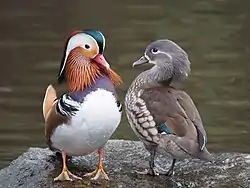鴛鴦
Chinese
| trad. (鴛鴦) | 鴛 | 鴦 | |
|---|---|---|---|
| simp. (鸳鸯) | 鸳 | 鸯 | |
| alternative forms | 夗央 | ||

.jpg.webp)
Pronunciation
Noun
鴛鴦
- mandarin duck (Classifier: 隻/只; 雙/双; 對/对)
- 鴛鴦雙棲,蝶雙飛;
- From: 1986, 許鏡清 Xu Jingqing (music) & 楊潔 Yang Jie (lyrics), 《女儿情》 "Maiden's Love"
- Yuānyāng shuāngqī, dié shuāngfēi;
Mǎnyuán chūnsè rě rén zuì. [Pinyin] - The Mandarin ducks, drake and hen, perch together, the butterflies fly side-by-side;
The inebriating spring's colours fill the garden.
滿園春色惹人醉。 [MSC, trad.]
鸳鸯双栖,蝶双飞;
满园春色惹人醉。 [MSC, simp.]
- (figurative) objects or people occurring in inseparable pairs
- (figurative) affectionate couple; happily married couple
- yuanyang (a beverage made from mixing coffee with Hong Kong-style milk tea) (Classifier: 杯)
Derived terms
Japanese

Etymology 1
| Kanji in this term | |
|---|---|
| 鴛 | 鴦 |
| おし | |
| Hyōgaiji | Hyōgaiji |
| jukujikun | |
From Old Japanese. First cited to the Nihon Shoki of 720.[1]
- /wosi/ → /oɕi/
Further derivation unclear. Possibly from Old and Classical Japanese adjective 愛し (woshi, modern reading oshi, “dear, loving”), from the way the ducks are believed to mate for life and seldom stray far from one another. This interpretation is traced back to readings applied to the Nihon Shoki and understandings of the 詩経 (Shikyō, “Shījīng” or “Classic of Poetry”).[1]
The spelling is from Chinese, with 鴛 representing the male bird and 鴦 representing the female bird.
Noun
- [from 720] (archaic, poetic) older name of the 鴛鴦 (oshidori, “mandarin duck”)
- [from 1220] a kind of 家紋 (kamon, “family crest”) featuring a mandarin duck
Usage notes
As with many terms that name organisms, this term is often spelled in katakana, especially in biological contexts (where katakana is customary), as オシ.
Derived terms
- アメリカオシ (amerika oshi)
Etymology 2
| Kanji in this term | |
|---|---|
| 鴛 | 鴦 |
| おしどり | |
| Hyōgaiji | Hyōgaiji |
| jukujikun | |
From Old Japanese. First cited to the Man'yōshū of 759.[1]
Compound of 鴛鴦 (oshi, “mandarin duck”) + 鳥 (tori, “bird”). The tori changes to dori as an instance of rendaku (連濁).
Noun
鴛鴦 • (oshidori) ←をしどり (wosidori)?
- [from 759] a mandarin duck, Aix galericulata
- [from 1739] (figurative) a pair of lovebirds, a loving couple
- [from 1791] a topknot or bun hairstyle wherein the hair is bunched on each side in a shape vaguely resembling two mandarin ducks
Usage notes
As with many terms that name organisms, this term is often spelled in katakana, especially in biological contexts (where katakana is customary), as オシドリ.
Etymology 3
| Kanji in this term | |
|---|---|
| 鴛 | 鴦 |
| えん Hyōgaiji |
おう Hyōgaiji |
| kan’on | |
/weɴau/ → /weɴɔː/ → /eɴoː/
From Middle Chinese 鴛鴦 (MC ʔʉɐn|ʔuən ʔɨɐŋ|ʔɑŋ, literally “male mandarin duck + female mandarin duck”). First cited in Japanese to a text from 835.[1]
Noun
鴛鴦 • (en'ō) ←ゑんあう (wen'au)?
- [from 835] (rare) a mandarin duck, Aix galericulata
- [from early 1100s] (rare, figurative) a pair of lovebirds, a loving couple
References
- “鴛鴦”, in 日本国語大辞典 (Nihon Kokugo Daijiten, “Nihon Kokugo Daijiten”) (in Japanese), 2nd edition, Tōkyō: Shogakukan, 2000, →ISBN
- 2006, 大辞林 (Daijirin), Third Edition (in Japanese), Tōkyō: Sanseidō, →ISBN
- 1997, 新明解国語辞典 (Shin Meikai Kokugo Jiten), Fifth Edition (in Japanese), Tōkyō: Sanseidō, →ISBN
- 1998, NHK日本語発音アクセント辞典 (NHK Japanese Pronunciation Accent Dictionary) (in Japanese), Tōkyō: NHK, →ISBN